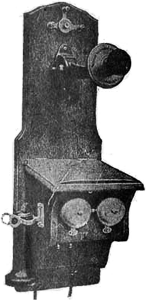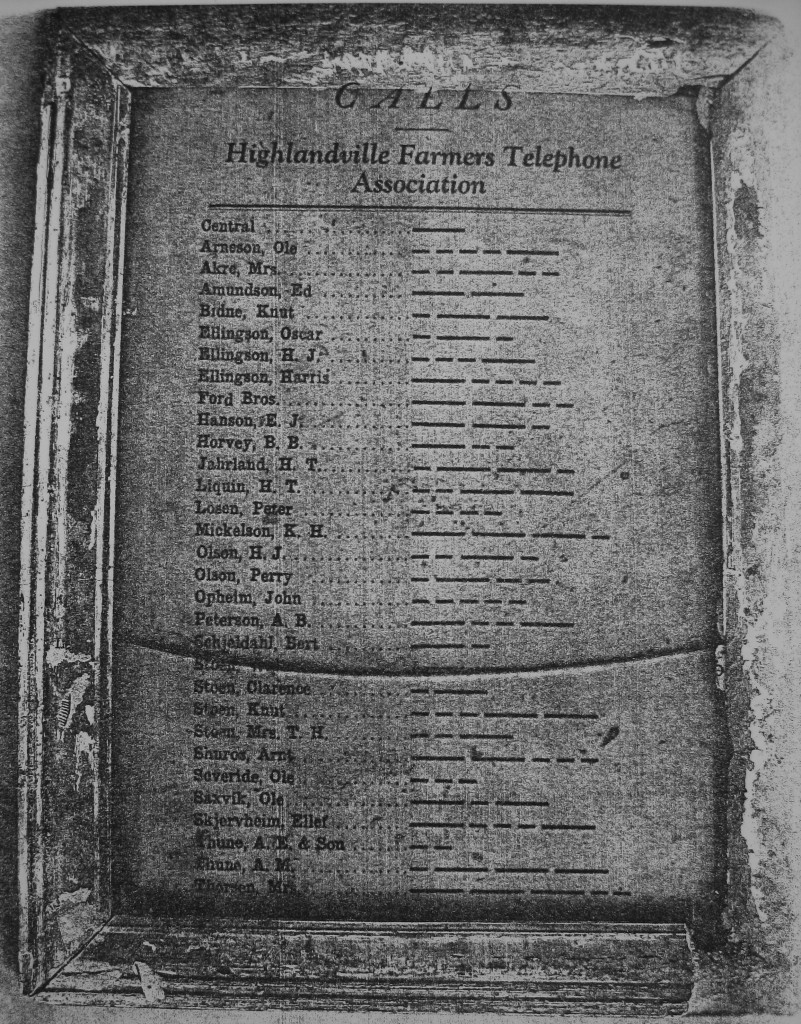 In 1886, the Iowa and Minnesota Telephone Company ran telephone lines through Decorah, connecting the region to long lines to the east, and Decorah became the central station for Winneshiek county lines in 1895. Farmers were slower to connect their farms and villages to the telephone network, as they had to organize and finance the enterprises on their own. Decades before being swallowed up into the “Bell” network, small private or co-op companies were founded in each community, and were extended and interlinked as communities raised money for the projects. Telephone service came to Highlandville and surrounding farms in 1902. A contemporary news article (unknown publication, March 31, 1902) reveals the plan and shares a snapshot of Highlandville’s development:
In 1886, the Iowa and Minnesota Telephone Company ran telephone lines through Decorah, connecting the region to long lines to the east, and Decorah became the central station for Winneshiek county lines in 1895. Farmers were slower to connect their farms and villages to the telephone network, as they had to organize and finance the enterprises on their own. Decades before being swallowed up into the “Bell” network, small private or co-op companies were founded in each community, and were extended and interlinked as communities raised money for the projects. Telephone service came to Highlandville and surrounding farms in 1902. A contemporary news article (unknown publication, March 31, 1902) reveals the plan and shares a snapshot of Highlandville’s development:
The Highlandville Farmer’s Telephone Company have organized with a membership at between 60 and [??0]. They are to have a central or switch at Highlandville, Ia. There will be two lines coming from the north and two from the south, besides the Sattre Farmer’s Telephone Company which is going to run a wire to Highlandville from the south; the Highlandville company’s aim to be connected with other farmer’s lines eventually connecting with Quandahl, Spring Grove, Locust, Mabel and Decorah. With Quandahl and Spring Grove they will be connected as soon as the line can be built. The Highlandville Farmer’s Telephone Company was the first[? – illegible] to be organized east of Locust, and seems to have a splendid organization with the following officers. A. E. Thune, President; L. G. Saxvick, Secretary; Henry Olson, Treasurer, who are all hustlers and have good business ability. If they build into Mabel and Decorah they will run a long distance business wire from their central to all the larger towns, and surely there will be several more lines that will run into Highlandville before long.
Highlandville is getting to be quite a business place as there are three stores, two farm machinery dealers, one doctor, one blacksmith shop, one carpenter shop with about a half dozen carpenters in the neighborhood, one creamery, two feed mills, one saw mill, one hotel, and there is a prospect for a butcher shop and a hall by next fall if not before. There has been some talk of getting an electric line to run in here or if some other railroad company would build a railroad from New Albin along the Iowa river to the junction of Bear Creek and along same ravine into Hesper and then on west they would connect with some other line we would be pleased. Please look over this you railroad magnates, we will help you all we can. We could raise several thousand dollars along the route as a bonus. Now don’t be bashful, if you mean business come and see us, we are both willing and able to do what is expected of us.
Bailey’s 1913 Past and Present of Winneshiek County confirms that the integration between Decorah’s and farmers’ telephone exchanges are complete:
The Standard Telephone Company (now owned by the “Bell” interests) maintains a local exchange that is well sustained, and through the toll lines and independent farm lines, every town in the county and hundreds of farm homes are in easy communication.
This Highlandville telephone directory was found in the archives of the Decorah Genealogy Association; based on the names listed, I would estimate the directory is from 1920-1940. The short and long dashes, refer to the ring pattern assigned to each party on the shared line.


